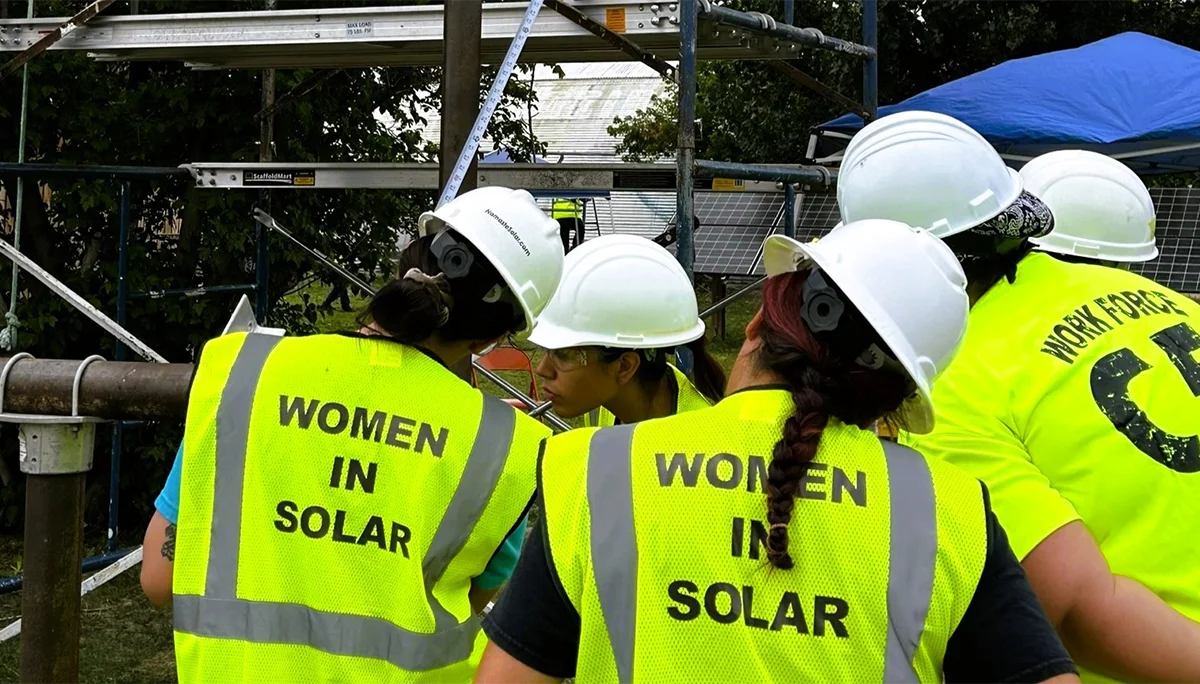Solar Warrior Training Program (SWTP)
Organization: Red Cloud Renewable
Red Cloud Renewable supports Native American communities by offering vital education in solar installation, sustainable building practices and weatherization techniques.
Location: Pine Ridge Indian Reservation, Oglala Lakota County, South Dakota
Communities benefiting directly from the project: Fourteen members comprising the Tribal Renewable Energy Coalition (TREC) Oglala Sioux Tribe, Rosebud Sioux Tribe, Sisseton Wahpeton Oyate, Flandreau Santee Sioux Tribe, Yankton Sioux Tribe, Northern Cheyenne Tribe, Northern Arapaho Tribe, Menominee Indian Tribe of Wisconsin, Chippewa Cree, Fort Peck Tribes, Three Affiliated Tribes, Turtle Mountain Band of Chippewa Indians, Blackfeet Tribe and Spirit Lake Tribe.
Country: United States
Other Organizations Involved: Remote Energy, Indigenized Energy, Solar Energy International and Robbins-de Beaumont Foundation.
 @ Alicia Hayden
@ Alicia Hayden
Background
The 2023 US Solar Jobs Census, published by the Interstate Renewable Energy Council (IREC), shows a significant underrepresentation of Indigenous community members in solar deployment. Lack of opportunities and resources plague these marginalized communities and, as a result, preclude tribal members from all 574 federally recognized tribes from meaningful training and employment opportunities.
Factors such as geographical isolation, limited resources, generational marginalization and unfamiliarity with evolving complexities in renewable energy training remain historical barriers for many Indigenous communities. The Solar Warrior Training Program seeks to remove these barriers through our Solar Education Program, a two- to four-week training course held at the Red Cloud Renewable Energy Center on the Pine Ridge Indian Reservation in South Dakota, by equipping participants with a technical understanding of photovoltaics, then supplementing that classroom knowledge with hands-on labs, allowing them to apply classroom concepts on mock PV system installations on our training yard.
Goals
Welcome members of all 574 federally recognized tribes and train one hundred (100) people to be rooftop and ground-mounted solar installation technicians between April 2024 and March 2026.
Main activities
Provide 40 hours of solar education, using a curriculum licensed from Solar Energy International (PV101) and 40 hours of hands-on labs (PV 201L), to deliver the requisite amount of classroom contact hours and hands-on experience required to qualify to sit for the PV Solar Associate credential offered from the North American Board of Certified Energy Practitioners (NABCEP).
Barriers associated with travel to and from the training center are removed with travel stipend allowances. On-site lodging, meals and mentorship are included with SWTP enrollment. Students receive critical job-readiness skills from a dedicated Career Services Coordinator, who provides résumé writing assistance, conducts mock interviews and offers referrals to our network in the renewable energy sector.
Expected outcomes
SWTP graduates return to their communities “rooftop ready,” with the training and experience that allows them to seek out and pursue a career as a certified solar installer. Our Career Services Coordinator will maintain communication with the graduates and update a graduate career tracking database. This allows data capture of important job placement metrics and helps us to better understand challenges associated with employment readiness and retention. Our wrap-around services approach offers crucial support that serves to mitigate many of the complexities associated with training deficits and job readiness.
Indigenous communities that have been impacted by grid-resiliency issues, ill-conceived clean energy policies and general exclusion of Indigenous voices in the climate resiliency space will benefit from SWTP graduates’ achievements and their concentrated pursuit of a career in the solar industry. In this manner, SWTP is helping to create a productive future, and works toward normalizing tribal member participation in solar deployment for tomorrow’s energy needs.